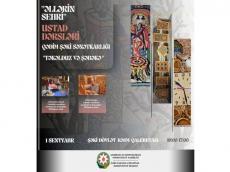|
|
TODAY.AZ / Arts & Entertainment
Master classes themed 'Magic of Hands' to be held in Shaki
29 August 2025 [13:17] - TODAY.AZ

On September 1, master classes titled "Magic of Hands" will be held at the Shaki State Art Gallery, organized by the Shaki-Zagatala Regional Department of Culture.
Many forms of art have been preserved and continue to develop in ancient Shaki, a city renowned as a center of craftsmanship.
The master classes will cover traditional arts such as shebeke (stained glass), tekelduz (embroidery), and other crafts.
Both local residents and visitors to the city are expected to participate in the event.
Shebeke is a traditional Azerbaijani art form of stained glass mosaic set in wooden frames without the use of glue or nails.
Originating in regions like Shaki, it showcases the high level of craftsmanship in woodworking and design. Artisans carve small wooden pieces, typically from walnut or boxwood, and fit them together with colorful glass to form intricate geometric and floral patterns.
Shebeke is not only decorative but also functional, filtering sunlight into vibrant displays of color. It is most famously seen in the windows of the Shaki Khans' Palace, representing a unique blend of artistry, precision, and cultural heritage.
Tekelduz is a traditional Azerbaijani form of decorative embroidery, most famously practiced in the city of Shaki. It is typically done by hand on black velvet fabric using silk threads, creating vibrant and detailed patterns.
The motifs often include floral, plant, and symbolic elements, reflecting the region's cultural and artistic heritage.
Tekelduz is usually stitched freehand without pre-drawn patterns, showcasing the artisan's skill and creativity.
Historically, it was used to decorate clothing, household textiles, and interior items like pillow covers, wall hangings, and traditional garments.
Today, tekelduz remains an important part of Shaki's craft tradition and is preserved through workshops and cultural programs.
URL: http://www.today.az/news/entertainment/261526.html
 Print version
Print version
Connect with us. Get latest news and updates.
See Also
- 23 October 2025 [17:28]
Azerbaijan's literary promoted at Frankfurt Int'l Book Fair - 23 October 2025 [16:23]
Int'l Snow Leopard Day: Global call for conservation - 23 October 2025 [12:18]
Program for Azerbaijan Dance Festival 2025 unveiled - 22 October 2025 [15:35]
Renowned children’s author joins literary meeting - 22 October 2025 [14:56]
Reza Deghati visits Baku to mark 5th anniversary of Victory Day - 22 October 2025 [14:20]
Kazakh musicians dazzle with stunning performance - 22 October 2025 [12:57]
'Wind of Culture' project launched in Garabagh region - 22 October 2025 [12:17]
Master classes dedicated to Uzeyir Hajibayli conclude - 22 October 2025 [10:42]
CINEMO Int'l Mobile Film Festival to be held for third time - 21 October 2025 [15:17]
Young Spectators Theater to stage new production
Most Popular
 Azerbaijan and Kazakhstan are taking region's geopolitics into their own hands
Azerbaijan and Kazakhstan are taking region's geopolitics into their own hands
 Vietnam and Finland vow to strengthen aviation ties
Vietnam and Finland vow to strengthen aviation ties
 President Ilham Aliyev presents Yagub Eyyubov with "Istiglal" Order
President Ilham Aliyev presents Yagub Eyyubov with "Istiglal" Order
 Pashinyan thanks President Ilham Aliyev for lifting transit restrictions toward Armenia
Pashinyan thanks President Ilham Aliyev for lifting transit restrictions toward Armenia
 Steel remains backbone of global industry amid shifting economic dynamics
Steel remains backbone of global industry amid shifting economic dynamics
 Azerbaijan targets 25 mln tons throughput at Baku Port
Azerbaijan targets 25 mln tons throughput at Baku Port
 Azerbaijani and Georgian prime ministers meet in Tbilisi
Azerbaijani and Georgian prime ministers meet in Tbilisi
